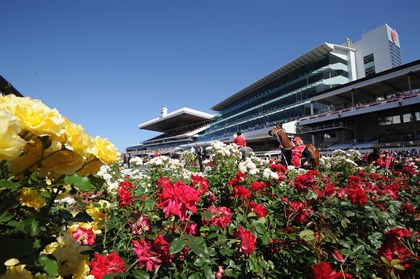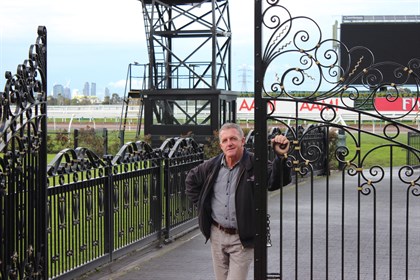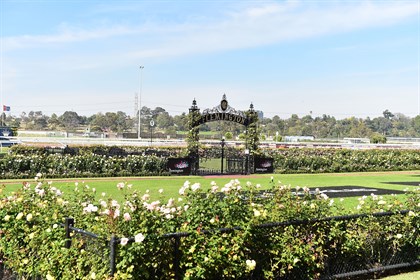|

|
This article has appeared previously with Equestrian Life. To see what's in the current issue, please click here.

The roses are now a key feature of Flemington’s Spring Racing Carnival.
© Getty Images
By Adele Severs
There are three things everyone knows about the Melbourne Cup carnival – the Cup is on the first Tuesday in November, the race is at 3 o’clock – and Flemington’s roses will be in full bloom.
What started out as an apprenticeship in 1976 has become a lifelong career for Terry Freeman, Keeper of the Roses at Flemington Racecourse. I met Terry on a cool, overcast day to discuss all things racing and roses. The rose bushes – all 16,000 of them – were just beginning to show signs of life after their winter break. As spring brings warmer days to Melbourne’s game of weather roulette, preparations are in full swing to ensure the roses look their best for Cup Day.

Terry Freeman has been looking after Flemington’s roses since he began his apprenticeship in 1976.
© Adele Severs
The roses, which were originally planted in place of annuals as a cost-cutting measure, have gone on to become a truly iconic part of Melbourne’s Spring Racing Carnival. Looking after them is a year-round job for Terry and his team of 17 gardeners. Preparations for Cup week begin with pruning in the last week of May and continue through to mid-August, as different varieties follow different timelines, and there are hundreds of varieties on show at Flemington in various hues. A recent addition is a deep burgundy rose named after super mare Black Caviar. It was planted the year before last and the team are “waiting to see how it performs”. A few years ago they had a rose named after another legendary mare, the great Makybe Diva. It was planted around her statue, however, it “wasn’t as good as the horse” and has since been removed.
The aim is to get all varieties flowering at once, and Terry admits the pressure to provide the perfect spectacle has increased over the years. Incredibly, there has only been one year in Terry’s 41 years at Flemington when the roses failed to perform. “Back in the ’90s they were late, they didn’t make the carnival. We knew early September that we weren’t going to make it, but it wasn’t until a week before Derby Day that the media actually picked up on it. It made the front page of the paper and was the lead story on the news that the roses wouldn’t be ready.” The late bloom was due to an unusually overcast, cold and wet September/October. “They flowered on Sandown Cup day when everyone was on the other side of town,” says Terry. “They looked tremendous but there was no one here to see them.”

The roses around the mounting yard are just beginning to bloom; the plan is to have them peak in time for the Spring Racing Carnival.
© Getty Images
So, is there a way to give the buds a nudge along? Terry says that they’ve “had pretty good results” spraying with liquid potassium and amino acid. This is a tactic they’ve employed a few times over the years, particularly for certain varieties that lag behind the rest. However, the best hurry-up is plenty of warm weather and sunshine throughout October.
For those with roses in their own gardens or down by the stables, Terry has a number of tips: Straw and manure work well as a fertiliser, in fact, this concoction was used at Flemington when straw was used in race-day stables. Nowadays, rubber matting is used, and there is less straw on offer for the garden. Terry recommends mushroom compost. While roses can survive with little care, Terry recommends three feeds through the growing season; at Flemington, the team use a product called Sudden Impact for Roses in mid-September, mid-January and at the end of March. Roses flower on new growth, so a good prune over winter when they are dormant is important. And removing spent flowers continuously encourages the plant to continue flowering. In terms of watering, Terry recommends three good soakings a week in warmer weather and says a drip system is best – overhead watering in warm weather promotes fungal conditions such as black spot.
At Flemington, new roses are being planted constantly – the team replaces around 1000 bushes each year. When planting a rose, it’s important to not plant in soil where roses have previously grown. At Flemington, new soil is trucked in to fulfil this requirement, however, the home gardener can simply remove a bucket of soil from the hole and replace it with soil from another section of the garden void of roses. If you do everything right, you can expect blooms from late October through to mid-May.

A good prune over the winter months - when roses are dormant - is important.
© Suzie Potter Photography
Terry had never set foot on a racecourse before he started at Flemington. Although he’s been convinced to hop on a horse once or twice, his first love is the garden. When asked how many times he’s picked a winner in the Cup, he laughs. “In 40 years, I’ve picked the Cup winner twice. Normally people ask me who I think will win, and then they put a line through it”.
As someone who has attended virtually every Cup meeting for 40 years, Terry has seen plenty. His first Melbourne Cup – a wet affair in 1976 when New Zealand horse Van der Hum paddled home to win – was the most memorable. “The crowd turned up as they always do, and got soaking wet. People turned up in goggles and flippers… that was back in the day when people use to dress up in weird outfits to come to the Cup.”

Roses in full bloom at Flemington.
© Suzie Potter Photography
READ THE LATEST NEWS ARTICLES HERE

|

|

